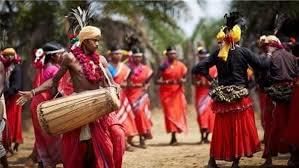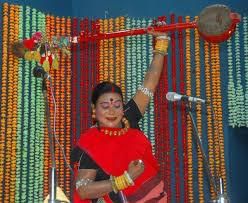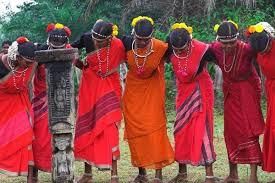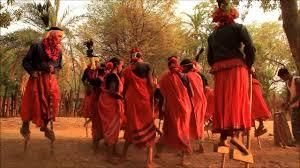CGPSC (Chhattisgarh) Exam > CGPSC (Chhattisgarh) Notes > Chhattisgarh State PSC (CGPSC) Preparation: All subjects > Chhattisgarh Folk Dance
Chhattisgarh Folk Dance | Chhattisgarh State PSC (CGPSC) Preparation: All subjects - CGPSC (Chhattisgarh) PDF Download
Folk Dances of Chhattisgarh
Most of the folk dance forms in Chhattisgarh are deeply connected with rituals, worship of deities, or seasonal changes. These dance forms are a remarkable blend of distinct costumes, accessories, and intricate acrobatic movements, reflecting the tribal or more accurately, the pristine way of life.
 Below is a detailed, though not exhaustive, list of prominent folk dance forms of Chhattisgarh:
Below is a detailed, though not exhaustive, list of prominent folk dance forms of Chhattisgarh:
Saila Folk Dance
- Quintessential Features: This dance is exclusively performed by boys during the post-harvest season in the Hindu month of Aghan (November-December). Resembling the Dandia dance, it involves boys striking sticks together in various styles. As a token of appreciation, the villagers offer paddy to the dancers. The Saila dancers visit every house and neighboring villages to perform this dance.
- Regional Variation: In some areas, the Saila dance is also performed as a Dussehra dance by the Baigas before Diwali. It is popular among the people of Sarguja, Chhindwara, and Baitul districts, though it is known as Danda Nach or Dandar Pate in these regions.
- Varieties of Saila: The Saila dance includes several variations, such as Baithiki Saila, Artari Saila, Thadi Saila, Chamka Kunda Saila, Chakramar Saila (lizard’s dance), and Shikari Saila.
- Style: Sometimes, dancers form a circle, standing on one leg and supporting each other by holding on to the person in front. They dance together, sometimes pairing off or moving in single or double lines, occasionally climbing on each other's backs. The climax is the Snake dance. The Mandars provide the rhythm, and as the beat quickens, so do the dancers' movements. The Saila songs, often starting with a monotonous refrain "Nanare nana," progressively lead to a more playful and lively conclusion.
Karma Folk Dance
- Quintessential Features: Performed during the autumnal Karma festival on the 11th day of the bright fortnight of Bhadrapada (August-September), this dance is common among tribal groups like the Gonds, Baigas, and Oraons. It signifies the end of the rainy season and the beginning of spring. The dance is associated with the worship of the Karam tree, which holds ritualistic importance among these tribes. The dance is performed to appease Karma Devta, hoping for his blessings. Participants dance in a circle, carefully passing a branch of the Karam tree, which is later washed in milk and planted in the center of the dancing area.
- Regional Variation: The Karma dance, also known as Karma Naachis, is popular among tribes in Jharkhand, Chhattisgarh, Madhya Pradesh, Bihar, Orissa, and other regions, with all forms centered around trees. Sub-varieties include Jhumar, Ektaria, Lahaki, Sirki, Pendehar, Dohoari, Tegwani, and more. In Sarguja district, the Majhwars dance the Karma at the start and end of the rainy season, while the Gonds and Baigas of Mandla and Bilaspur districts perform it at any time. Various tribes use instruments like Thumki, Payri, Chhalla, and Jhumki during the dance.
- Style: Men and women dance to instruments like Thumki, Chhalla, Payri, and Jhumki, with the drum (timki) being the main instrument. The dancers, in ethnic costumes and jewelry, move their feet in rhythm, with men leaping forward and women bending low to the ground. The dance, associated with the fertility cult, involves the dancers forming a circle, holding each other's waists, and moving rhythmically. The Karma dance symbolizes the bringing of green branches in spring, often performed around a tree set up in the village.
Sua Nacha or Suwa Folk Dance
- Quintessential Features: The Sua or Sugga dance, performed by the women of Chhattisgarh and the Maikal Hills, is known for its elegance and grace. The word ‘Sua’ means parrot. Women engage in this dance a month before Diwali.
- Style: The dance involves women imitating the walk and movements of a parrot, bending and jerking their heads in a bird-like manner to the clapping of hands. Groups of girls travel to neighboring villages to showcase their dance, often receiving similar groups in their own village. They prepare a wooden parrot (Sugga) placed on an earthen pot covered with paddy shoots. One girl carries the pot on her head, standing as a revolving figure in the middle of the group. No instruments are used except for a wooden clapper called Thiski, providing rhythm. The Gonds and Baigas are predominant in this dance, with entertainers singing and moving around, accompanied by loud clapping.
Pandavani Folk Dance

- Quintessential Features: Pandavani is a folk ballad that narrates the tales of the Pandavas, central characters of the epic Mahabharata. This dance form involves a group of dancers led by a main artist, supported by musicians.
- Styles of Narration: The two main styles of narration are Vedamati, where the lead artist sits on the floor throughout the performance, and Kapalik, where the lead artist actively narrates and acts out characters and scenes. Teejan Bai, a renowned performer from Chhattisgarh, has received several awards, including the Padma Shri and Padma Bhushan, for her contribution to this dance form.
Panthi Folk Dance
- Quintessential Features: Panthi Dance is a significant ritual of the Satnami community of Chhattisgarh. The Satnamis believe in the philosophy of Nirvana, and their dance reflects this ideology. The community celebrates the birth anniversary of Guru Ghasidas on Maghi Purnima. This dance, which showcases the rich cultural heritage and traditional legacies of the tribal groups in the Durg region, combines various steps and patterns, often conveying the teachings of their holy teacher. Some scholars consider it a form of martial dance.
- Style: Dancers wear colorful dresses, singing praises of their guru. A group of men often constructs a pyramid-like formation, with the leader singing. Rhythmic instruments like the mandar, drum, and jhanjh accompany the dance. The performance begins slowly, with the leader singing solo, gradually picking up pace as the dancers form pyramid-like structures. The performance ends with a quick and mesmerizing display of songs, music, and dance. The dancers present various ‘Mudras’ (gestures) like Jait Khamb, Jai Stambh, Dharti Pranam (honoring the land), and Phool Arpan (offering flowers) to honor their Guru. Devdas Banjara, a chief exponent of Panthi dance, showcased this legacy to the world, earning the Guru Ghasi Das Award and the President’s Award for his contributions.
Raut Nacha Folk Dance
- Quintessential Features: Known as the Folk dance of cowherds, Raut Nacha is performed by the Yadava/Yaduvanshis, a caste in Chhattisgarh who consider themselves descendants of Krishna. The dance depicts the fierce battle between King Kansa and the cowherds, representing the victory of good over evil. Celebrated on the 11th day after Diwali, it corresponds with ‘dev udhni ekadashi’ in the Hindu calendar, a time believed to be when the Gods are awake. Raut Nach closely resembles the Rasa-lila of Lord Sri Krishna.
- Style: The dance is competitive, with teams from different villages, sometimes consisting of up to 100 male members, led by a young boy dressed as Lord Krishna. Dancers use sticks and shields, adorned with bells at their waists and ankles, to enact ancient battles. They wear bright, colorful costumes and perform to the beat of music and songs. The accompanying songs, called Dohe, describe tribal life and philosophy, adding to the dance's diversity. Instruments like Mandals, dhols, and drums dominate the musical accompaniment.
Jhirliti Folk Dance

- Quintessential Features: Jhirliti, lacking a fixed pattern, is challenging to categorize as a set dance form. This dance is similar to a Halloween-like ritual performed by children in the Bastar region and Chhattisgarh. As the sun sets, children dressed in rags and worn-out costumes, with faces painted with chalk, coal, and powdered rangoli, dance in circles in front of village houses, receiving ration as a token of gratitude. The children celebrate with the collected items.
Gendi Folk Dance
- Quintessential Features: In Chhattisgarh, ‘Gendi’ refers to a stick. Dancers perform on two long bamboo sticks or any firm sticks, maneuvering through the crowd of other Gendi-ridden dancers. The dance, marked by acrobatic skills and percussive rhythms, requires excellent balance as dancers sway to the tribal acoustics, making it a captivating folk tradition.
Rahas Folk Dance
- Quintessential Features: Performed during festivals in Chhattisgarh, Rahas is popular in the Dhamtari District. The rural folk, dressed in headgear and traditional attire, perform the dance to the rhythms of long-shaped drums. The central theme of Rahas is the Rasa-Lila of Krishna and Radha.
Kaksar Folk Dance
- Quintessential Features: Kaksar is a festival dance performed by the Abhujmaria of Bastar. Before the rains, Maria cultivators in each village worship the deity to ensure a bountiful harvest. Kaksar, a group dance involving young boys and girls, is performed to invoke the deity’s blessings. Boys wear long white robes, while girls dress in all their finery. This dance also offers young boys and girls a chance to choose their life partners, with marriages often celebrated afterward. In one form of the dance, dancers carry dummy horses on their shoulders, moving in a wide circle, creating a mesmerizing atmosphere with melodious music and tinkling bells.
Chaitra Festival Folk Dance
- Quintessential Features: The Chaitra festival dance is a famous dance of the Gonds in Bastar, performed after the harvest to thank Goddess Annapurna and seek blessings for the next crop.
- Style: Men and women dance in circles, semi-circles, or rows, holding each other’s waists. Peacock feathers on the head and colorful costumes are distinctive, along with garlands of shells and pearls. The dancers move rhythmically to the music of instruments like the Shehnai, Nagada, Timki, Tapri, Dholak, and Maduri. Wind instruments like Singha and Kohuk are also used. A similar dance is Rina, known as Tapadi among the Baigas, performed by Gond women in Mandla district after Diwali.
Gaur Folk Dance
- Quintessential Features: Popular among the Sing Marias or Tallaguda Marias (bison-horn Marias) of South Bastar, the Gaur dance symbolizes the hunting spirit of the tribe. The word ‘Gaur’ means a ferocious bison.
- Style: The dance begins with the sound of a bamboo trumpet or horn. Men, wearing head-dresses decorated with cowries and peacock feathers, make their way to the dancing ground, joined by women adorned with brass fillets and bead necklaces. Women carry dancing sticks called Tirududi, tapping them to the drum beats, while men toss the horns and feathers of their headgears to the rising tempo, giving the dance a wilder touch. The bison dance involves imitating bison movements, with men performing like frisky bulls, hurling grass into the air, charging, and tossing horns.
Muria Dances

- Quintessential Features: The Murias of North Bastar are trained in the Ghotul, where they learn various community dances. Before any dance at a wedding or festive occasion, the Murias first worship their drums. They often begin with an invocation to ‘Lingo Pen,’ the phallic deity and founder of the Ghotul institution, believed to be the first musician who taught drumming to tribal boys.
- Style: The dancing site is usually near the Ghotul compound. During marriage celebrations, the Muria boys and girls perform the Har Endanna dance, involving a variety of movements, with dancers and drummers participating in intricate patterns. The Hulki, a favorite dance, involves boys moving in a ring while girls weave through them. The Karsana is performed purely for enjoyment, with quick movements and rich rhythmic nuances. Pus Kolang, a stick dance, is another popular dance performed in February. The Bhils, inhabiting the Vindhya ranges and the banks of the Narmada, perform dances like Bhagoriah and Gavar, characterized by wild shouts, lusty songs, and rhythmic movements with drums. During Holi, the Bhils and Garasias perform the Ger dance, with women forming circles and performing the Loor dance. The Pali dance involves women forming rows, with variations like Duipali, Pachmundya Pali, and Ondi-Chiti Pali.
- Festive Dances: The Diwali dances of the Ahirs and Rawats in Bilaspur and Raipur districts have a vital appeal. Ahir dancers wear tight-fitting shirts, studded with bells, and perform the Danda dance with vigor.
Question for Chhattisgarh Folk DanceTry yourself: Which folk dance of Chhattisgarh involves dancers imitating the walk and movements of a parrot?View Solution
The document Chhattisgarh Folk Dance | Chhattisgarh State PSC (CGPSC) Preparation: All subjects - CGPSC (Chhattisgarh) is a part of the CGPSC (Chhattisgarh) Course Chhattisgarh State PSC (CGPSC) Preparation: All subjects.
All you need of CGPSC (Chhattisgarh) at this link: CGPSC (Chhattisgarh)
FAQs on Chhattisgarh Folk Dance - Chhattisgarh State PSC (CGPSC) Preparation: All subjects - CGPSC (Chhattisgarh)
| 1. What are the quintessential features of Panthi dance? |  |
Ans. Panthi dance is characterized by its energetic and vibrant movements, which are often accompanied by traditional musical instruments like dhol and mandar. The dancers wear colorful costumes and perform in groups, showcasing themes of rural life and festivals.
| 2. What are some indigenous folk dances of the Vindhya region? |  |
Ans. Some indigenous folk dances of the Vindhya region include Pandavani and Panthi dance, which are unique to the culture of the region and showcase the rich traditions of the local communities.
Related Searches





















